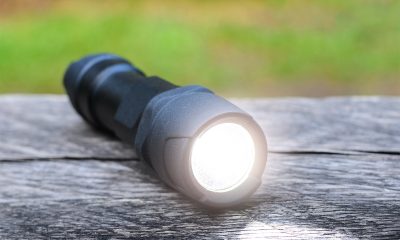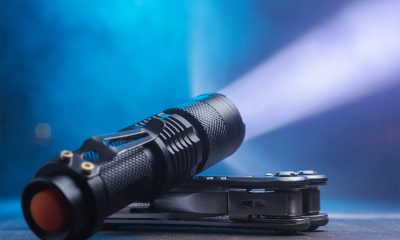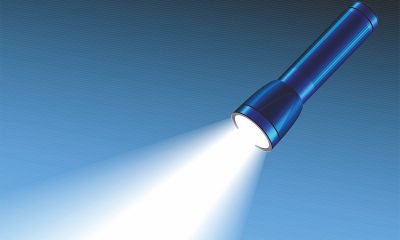Carry it around wherever you need light
A camping lantern is a portable area light that provides omnidirectional or flood lighting to illuminate an outdoor environment. This battery-operated light is designed to be easily carried around wherever you need light, whether camping, fishing, boating, climbing, to use as a patio light, or to have on hand in emergencies. Hands-free capability is a signature feature of camping lanterns. Put the lantern on the table, hang it in a tent on a tree branch, or even attach it to any metal surface with the built-in magnet. LED technology revolutionized artificial lighting and drives continuous advances in performance and reliability. Switching to LED lighting not only delivers radical improvements in efficiency, lifespan and functionality over legacy products, but also brings a whole new world of design possibilities. The technology allows camping lanterns to produce considerably more lumens, operate for a much longer period of time on a single battery discharge, offer significantly improved robustness and usability, and deliver the luxury of sophistication and convenience.
Design and construction
An LED lantern features a large optical assembly through which the LEDs shine over a wide area. A typical camping lantern produces several hundred lumens, but the light output of this type of products can range from several ten lumens to several thousand lumens. The LED module that is designed to deliver a wide flood or wide symmetrical pattern of light is comprised of an array of discrete SMD LEDs or an integrated COB LED array. The light emitting surface (LES) plays a significant role in determining optical system performance.
The use of discrete SMD LEDs provides flexibility in designing a multi-directional LES that allows for optimum light distribution. COB LEDs are famed for their high flux density and high uniformity distribution of light. To soften the harshness of LEDs and maximize the LES, a plastic lens containing a light diffusion additive is often used on an LED lantern. Luminous flux from light source is evenly to all directions through scattered penetration.
To reduce optical diffusion loss while smashing the discomforting luminance, a transparent optical lens is used instead in some products. Adding diffusing features on the lens surface can change the distribution of luminous flux preferably to desired directions thus eliminating LED hotspots and shaping light intensity distribution curves (LIDC).
Optical control in LED lanterns can also be accomplished with an internal reflection system in which the LEDs are concealed from every angle of view but illuminate a reflective surface to provide gentle, uniform area lighting with minimal optical loss.
Battery technology
Besides high efficacy lighting, the performance of the integrated power source is critically important to the lumen output, run time and reliability of a camping lantern. Capacity is among the most important characteristics of the battery performance. It’s logical to incorporate a battery with the largest possible capacity. In portable lighting applications, however, an appropriate compromise between the capacity and physical volume of the battery must be made in order to create a dependable product with excellent portability. Primary batteries which are designed to be cycled (fully discharged) only once are cheap upfront but expensive over time. They’re typically used in systems that have a low frequency of utilization. Secondary batteries, which are commonly known as rechargeable batteries, have an increasing popularity in portable lighting applications due to the constant performance improvements in lithium-ion (Li-ion) chemistries.
With an energy density that is considerably higher than conventional nickel-cadmium (NiCd) and nickel-metal-hybrid (NiMH) batteries, lithium-ion batteries provide a compact and powerful energy source for camping lanterns. Lithium-ion batteries have a long cycle life and can be cycled to 80% DOD (discharged to 80% of their capacity). Battery management systems must be used with lithium-ion batteries to prevent electrical abuse that would lead to a fire or explosion. A camping lantern may be designed with a due fuel system which allows the light to run off rechargeable or disposable batteries. The battery pack is designed to accommodate, for example, a rechargeable 18650 lithium-ion battery or two CR123A lithium batteries.
Driver and control circuitry
The brain of an LED lantern is the driver and control circuitry. LEDs are current driven device. If the drive current is not properly regulated, unwanted visible effects such as flickering can occur. Overdriving what an LED is rated for may result in the nucleation and growth of thread dislocations and other crystalline defects in the active region of the diode, which can induce efficiency degradation and lifetime shortening.
A constant current LED driver is necessary to regulate battery power and provide an appropriate voltage and current to the LED load. The LED driver usually comes with a dimming function and executes commands from a microcontroller to produce light in different levels (e.g., high, medium, low, and nightlight outputs) and in different modes (e.g., steady output mode, flash SOS mode for emergency signaling). In solar powered LED lanterns, a solar charge controller is incorporated to monitor and control the power going into the battery so that the power generated by the solar module does not overcharge the battery.
Additional features
LED are often equipped with additional functionalities. An LED lantern may double as a flashlight with a convertible optical system or a separate spotlight module. The battery pack of a rechargeable LED lantern may act as a power bank for charging mobile USB devices. Regardless the forms and features, the design of a camping lantern will prioritize its ability to survive adverse environmental conditions and whatever abuse an outdoor adventure puts it through. A high level of impact resistance allows camping lights to survive drops with ease. These luminaires are sealed to exclude water and dust from entering the enclosure. Plastic optical lenses are UV stabilized to enhance weathering capabilities.














Loading...